NEONATOLOGY ON THE WEB
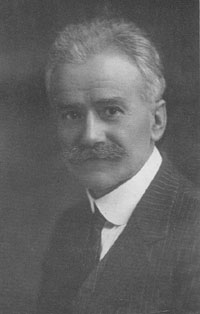
|
The Baby Incubators on the "Pike."
A Study of the Care of Premature Infants in Incubator
Hospitals Erected for Show Purposes.
Part 1.
By John Zahorsky, M.D.,
St. Louis, Mo.
St. Louis Courier of Medicine 31(6):345-358,
December, 1904.
|
Although I have taken some pains to search medical literature, a
comprehensive account of results obtained at the so-called show
incubators was not found. Neither can I find to whom we owe this new
method of entertaining and instructing the people. The London
Lancet of May 29, 1897, editorially discusses the care of infants
in incubators and gives an account of the first public incubators in
England. After narrating a brief history of the baby incubators and
discussing their success in foreign countries, it is stated that in
England the question of incubators is of particular interest, for
though the general death-rate of infants had decreased considerably,
the death-rate due to premature births had, on the contrary, greatly
increased.
Some authorities had placed this increase at 40 per cent. The
London tables of mortality show that whereas the deaths registered as
due to premature births amounted to 1930 in 1886, this figure rose to
2534 in 1896. "Under these circumstances any successful attempt to
improve the construction of incubators and to render this life-saving
apparatus available to the general public must be welcome." It is
furthermore stated that they "were informed" that this had been
achieved at Earl's Court, but does not give any source of the
information. In these editorial notes we are informed that Messrs
Samuel Schenkein and Martin Coney had opened an exhibition of baby
incubators during the Victorian Era Exposition at Earl's Court.
"The main feature of this new incubator is the fact that it
requires no constant and skilled care. [!!] It works
automatically; both ventilation and heat are maintained without any
fluctuation whatever, not only for an hour but for days." The writer
evidently obtained his information from the dealers in incubators. He
later admitted that the variations were no more than 2° C. The
incubators used were the Altmann incubators. From the description I
judge that it was a modification of the Lion incubator.
The ventilation was accomplished by a pipe conducted through the
wall or window which delivered the air to a box fastened to the side
of the incubators, where it was moistened and washed by passing
through a layer of cotton over a saucer containing water or an
antiseptic solution. We are really surprised to hear that the
air passed over an antiseptic solution. This must also be some
information obtained from the dealers. Medical science is not aware
of any antiseptic which destroys bacteria in the air and at the same
time is harmless to breathe, especially for young infants.
The description of the air and heating apparatus corresponds to
the incubators used in St. Louis, except that the thermostat was
different. The thermostat was in the shape of a W made of two metals,
one of which expanded and contracted while the other did not. This
unequal expansion turned off the gas or turned down the lamp. It was
said to have been very delicate, the slightest change affecting it,
etc.
Most remarkable is the assertion that as the incubators were so
perfectly constructed skilled attendance was not required, as
if the keeping a box up to a constant temperature is the whole
difficulty in the care of premature infants.
A further description of the institute is found in the London
Lancet of July 17, 1897. After announcing that the members of the
press were invited to inspect the incubators at Earl's Court, it is
stated that the incubators are in charge of a trained nurse from
Paris who is assisted by the wet nurses who furnish food for the
infants.
The institute comprises three compartments: On one side were
sleeping accommodations for the two wet nurses and the trained nurse;
on the opposite side was a nursery where the babies were fed, washed,
etc. The public was admitted to the central room where the incubators
stood. Messrs Coney and Schenkein, and two physicians attend. We can
not but help smiling on reading that the babies were fed every two
hours in day time and at night the watchman awakened the nurses every
three hours that they might feed the infants. They were generally fed
from the breast.
I have given the description of this public incubator institute
somewhat at length since it is the only that can be found. That this
system had great defects in construction and was defective in its
nursing capacity is self-evident. How much improvement these
gentlemen accomplished at other institutions of similar character
(Berlin, Buffalo and New York) I can not state. That the editor of
the Lancet could grow enthusiastic over it only emphasizes the
general ignorance of such institutions at that time.
The financial success of the incubator shown at Earl's Court seems
to have invited many other showmen to open such an exhibition, and we
find Messrs Coney and Schenkein in an open letter (London
Lancet, September 18, 1897) deeming it their "duty to warn
members of the medical profession, also nurses, parents, and public
institutions not to entrust their children to any applicant
whatsoever without first taking the precaution to assure themselves
that they will not be made the victims of showmen, as well of
inexperienced or irresponsible persons who seek to trade upon the
established reputation of an invention that has been recognized by
both the medical and lay press." Is this not the voice of pure
commercialism?
Indeed, in the following year (London Lancet, Feb. 5, 1898)
the editor regrets that the success at Earl's Court has attracted the
cupidity of public showmen. The methods used at the London World's
Fair are attacked especially because the air is not obtained from the
outside. The incubators at Barnum & Bailey's Circus seem to have
been under better management, but the Lancet indignantly
exclaims: "What connection is there between the serious matter of
saving human life, and the bearded woman, the dog-faced man, the
elephants, the performing horses and pigs, and the clowns and
acrobats, that constitute the chief attraction of Olympia!"
Some notion of this incubator is obtained from an editorial in
Pediatrics, April 1, 1898. It seems, however, that the
periodical obtained most of its data from an English newspaper. I
quote -- "one of the most popular of the 'side-shows' at Olympia, now
the headquarters of Bailey's Greatest Show on Earth is the baby
incubator department. These incubators are of English manufacture
throughout, and are, moreover, far more elaborate contrivances than
their German and French prototypes. All the infants treated by this
method are exceedingly delicate, one of them weighing only 20 ounces,
while another is barely 9 inches long, yet it is asserted that
between 80 and 90 per cent are saved alive." Then follows a
description of the incubator; the air is received from the outside
through a metal pipe; the baby lies in a hermetically sealed glass
chamber; the air is filtered by passing through cotton which has been
impregnated with a powerful germicide. Infants are fed every two
hours in the day time and three times at night. The greatest care is
taken to prevent their inhalation of the outside air during feeding.
Sterilized milk, well diluted, is the food. There is an automatic
regulator of the heat, and when anything is wrong an electric bell
rings.
We read that in all these incubators the results are very good.
But such reports are utterly worthless, since no exact statistics
have been published. In order to ascertain whether the results were
very good we should have to know the number, age and weight of the
babies admitted and the exact death rate. This has never been
furnished by physicians in charge of these incubators. Why?
The accusation made against some of them is that babies weighing
less than a certain number of ounces and under seven and a half
months' gestation are not received, but I have no way of verifying
this statement.
The feeling of the medical profession is against the show
incubators, of this there can be no doubt. On the one hand there is a
prejudice that showmen can not have the proper sentiment toward these
little ones and may sacrifice proper requirements of care for show
purposes; on the other hand, we feel it degrading to human sentiment
to make an exhibition of human misfortunes, especially in the shape
of tiny infants. It is perfectly rational, then, to inquire into the
advantages that an incubator institute has to offer. In the first
place, such an institution, when connected with a large Fair or
Exposition is financially able to give these young infants attention
which could not be procured otherwise. When it is recalled that each
infant at the St. Louis Fair cost the company about $15 a day, the
magnitude of the task is apparent, and if this expenditure is
life-saving it would be a great boon to the poorer class. Money is
necessary to save the life of premature infants. It is questionable
whether any hospital or asylum could undertake this work unless the
State would give a liberal support.
In the second place, such an institution has a great educational
value and, no doubt, these exhibitions have contributed largely to
the general feeling that an effort should be made to save premature
infants and not allow them to die as a matter of course.
In the third place, such an institution serves the purpose of a
hospital where premature infants may be scientifically studied, and
in this way advances our knowledge and improves our methods of
rearing them. Unfortunately, as far as I am aware, the material at
these exhibitions in the past have not been utilized; or, at least,
the scientific world has not received any increment to its knowledge
from this source. It is for this reason especially that I take
pleasure in giving the full particulars of the incubators at the
Louisiana Purchase Exhibition, and record the details of our efforts
to save life during the three months in which I had charge.
But there is one objection to these exhibitions which must be
carefully considered, and this objection holds good for all infant
hospitals and asylums -- namely, the death-rate of infants in such
institutions is probably much higher than in private families. The
danger of "hospitalism" can not be denied, but more of this later.
After all, as long as the people are interested in such
exhibitions, and will pay a good admission fee, these institutions
will flourish and it behooves the medical profession to see that
safeguards are thrown around them, and rules of conduct must be
accurately formulated. On the construction and management more will
be told later.
The Incubators on the Pike.
The Imperial Concession Company, a company formed principally of
St. Louis business men, with Mr. E. M. Bayliss manager, opened the
incubators about June 1, 1904. While the purpose of this company was
simply to make money, the character of the men governing the
institution, precluded the entertainment of the notion that the
infants would be neglected in any way. These business men did not
claim to know anything about the care of premature infants (neither
do the capitalists who build hospitals possess any special knowledge
concerning the care of the sick) but they were willing to do anything
that science has taught was necessary. Miss Kelly, a trained nurse,
who had had considerable experience with premature and other babies
was put in charge, a physician was procured who had gone East
especially to study the care of these infants, and only trained
nurses were employed to take care of the babies.
Everything went very well until the hot weather, when, through
some error, a very virulent pathogenic micro-organism was introduced
and the catastrophe of an epidemic summer diarrhea started among the
babies. The losses of very young babies was increased by the death of
several "graduates," and the mortality was altogether higher than was
desired. On September 1st the death-rate had been about 50 per cent
-- the death-rate of infantile hospitalism.
The attending physician resigned and during the month of August
others were employed.
Meanwhile, certain "specialists" in incubator exhibitions,
probably chagrined by the fact that they had not obtained the
concession, although they had experience in many other expositions,
began to assail the management in every conceivable way. Some
sensational newspapers tried to make a scandal out of the baby
incubators on the Pike.
But the management and the officials of the Exhibition took up the
subject; a committee of the best local physicians was appointed to
investigate the exhibition and a few changes in the building were
ordered, one of which was that a glass partition should separate the
incubators from the public. But these alterations, while helpful, had
little to do with improving conditions. The catastrophe was almost
over. The management spared no expense in trying to remedy every
defect. Vast sums were spent in some things which really were
impractical -- such as a gas pump to increase the gas pressure,
electric heaters, etc. The gas pump failed to operate at times and
the electric heating of water was too slow.
How to avoid these catastrophes, as Finkelstein has aptly termed
them, has been clearly laid down, but occasionally, in spite of care,
it may occur. What seemed especially hard was the bitter attacks of
these "specialists" in incubator institutes, although the report of
Major Raymond, U.S.A., showed that the death-rate in incubator babies
was but 50 per cent. These figures are no higher than those of
Adriance -- 60 per cent, and about the same as those of Voorhees', 50
per cent; consequently, these scandalous vituperations were uncalled
for.
Still this rivalry among different individuals, who wish to
conduct incubators for show purposes, can have only a healthful
influence, in that rivals will watch each other and attempt to find
fault with the management. This will stimulate all to do their best.
I took charge of the medical management on September 1st, and was
ably assisted, first by Dr. O'Neal and later by Dr. F. N. Gordon, who
were the resident physicians. I made two, but more often three,
visits to the incubators daily. This study then includes our
experience from September 1 to November 30, 1904. I feel it would be
unjust to make a complete report on the previous experiences of the
other physicians as I have incomplete data, but I shall take the
liberty to refer to some phases of it, as shown by the clinical
records in my possession.
II.
The Building.
The incubators and nursery were in a brick fireproof building,
while the dormitories for nurses and other attendants were in a
separate part of the building which was constructed, as most other
exposition buildings, of a wooden frame work and staff. (Fig. 1).
Room for the Incubators.
The incubators, twelve in number, stood in narrow hall about three
feet apart and separated from a large room, in which the public came
and went, by a glass partition. This partition was built about the
middle of the season on recommendation of the committee appointed by
the Board of Health; previous to this the incubators were separated
from the public only by an iron railing. Not only were the nurses
constantly annoyed by questions from the interested visitors, but the
air became surcharged at times with carbon dioxide and obnoxious
effluvia from thousands of sight-seers. Hence, I deem it of the
utmost importance that the room in which the incubators stand be
entirely separated from the public; for the air of a room, no matter
how thoroughly ventilated, in which many people congregate is unfit
for young infants. Every time the door of an incubator is opened this
foul air enters the baby's resting place. There is no easier way to
induce the symptom complex of hospitalism. (Fig. 3)
Therefore the air in the visiting room had no connection whatever
with the incubator ward, and the air supply, outlet and inlet, was
entirely separate. For, to place the incubators in the public room
subjects the little ones to grave dangers of intoxication and
infection every time the door of the incubator is opened.
The incubator room received the air supply by a large opening in
the ceiling at one end, while at the opposite end two large electric
exhaust fans continually emptied the atmospheric contents. While the
narrow room was, theoretically, too small, practically with this
forced ventilation the air remained perfectly pure. During the cold
weather the room was heated by a wood-burning stove at one end of the
room, almost immediately beneath the opening for the entrance of air.
An effort was made to keep the temperature of the air about 75°
F., or a little higher. At this end also was a door which opened into
the nursery, a corner of which was walled off for a diet kitchen and
dressing room. This door remained closed most of the time so that the
air from the nursery could not enter the incubator room.
The Diet Kitchen.
The diet kitchen and dressing room was made from a corner of the
nursery, walled off by a thin partition from the nursery and
ventilated by an opening in the ceiling and an outlet shaft extending
from a few inches from the floor upward and constantly emptied by an
electric exhaust fan. The sterilization of the bottles, heating of
the thermophores, warming of the milk etc., was done on a gas stove.
The objectionable odor of gas was obviated by having a large hood
with a flue running to the top of the building. This removed the hot
air and combustion products. A trial was made with electric heaters
but were found impracticable, since the heating of large quantities
of water was too slow. The heat from the gas stove kept the diet
kitchen at a temperature of 75 to 85° F. During the cold weather
the temperature was kept up by a wood-burning stone which stood near
the door of the diet kitchen.
For the purpose of dressing the babies, shelves were attached to
each side of the kitchen. Pads of cotton covered with sterilized
gauze were laid upon them. Underneath these pads were electrotherms
which could be heated if for any reason a premature infant with
feeble heating power had to remain in the dressing room for a short
time.
Altogether the objectionable features of having the diet kitchen
and dressing room together were minimized, but in all such
institutions separate rooms should be provided.
The Nursery.
The nursery also was separated from the public by large glass
windows. It was ventilated by doors and numerous windows, and heated,
during part of October and November, by two wood-burning stoves. The
floor was covered with linoleum which was thoroughly cleaned every
day.
The Incubators.
The incubators used were manufactured by the Kny-Scheerer Company,
of New York. It is a modification of the Lion incubator. The
principal improvement consists in the use of a thermophore placed in
a metal drawer in the lower part of the incubator; an improvement
probably adopted from the suggestion of L. Furst and others
(Berliner Klin. Woch., November 20, 1899). This thermophore is
rectangular metal box which contains crystals of some salt (sodium
acetate?) which when placed in boiling water liquify. The process of
recrystalization going on slowly, the metal box radiates heat for
several hours. The principal heating of the incubator is accomplished
by means of a coil of metal tubing which contains water. The water
pipe extends to the outside of the incubator where it enters a
cylinder lined with fire-clay. Within this is a gas flame which heats
the water. For most purposes an ordinary Bunsen burner is sufficient.
In a few incubators a larger gas heater was employed. (Fig. 4).
The products of combustion from these heaters were carried off by
means of a tin pipe running from the top of the heating cylinder
through the ceiling of the incubator room. The incubator is made
entirely of nickel plated iron, glass and tin. The two sides have
large glass windows and the double doors in front are made entirely
of glass except a narrow framework. The size of the incubator chamber
is -- length, 56 cm., breadth, 46 cm., height, 46 cm. It might with
benefit be made a little wider, for a larger chamber would be
preferable on account of the greater ease in attending to the baby,
and the heating capacity would be more stable. Then, again, the flow
of the ventilation would need be less swift.
About 10 cm. above the water coil is a platform made of plated
steel wire on which the infant lies, but separated from it by a pad
of cotton covered with rubber cloth over which fresh sterilized gauze
was placed daily.
The air enters the incubator below the water coil and strikes a
flange within the coil which spreads the air current. It rises on all
sides of the infant and where the pad is not impervious may pass
through the frame. On the top of the chamber is a circular opening
for the egress of air. This has a pipe attached in the upper end of
which is a small metal fan (anemometer) which by the rapidity of
rotation indicates the velocity of outflow. A thermometer is attached
on a level of the infant to the side of the incubator walls. A
hygrometer is also one of the valuable instruments in each incubator.
The Air Supply.
The air supply was received through a large tin pipe (diameter, 24
cm.) which extended from the roof of the building through the ceiling
and emptied into a similar pipe which ran horizontally the whole
length of the incubator room. From this horizontal pipe smaller tubes
(diameter, 7 cm.) carried the air to the incubators. The air was
forced through these pipes by an electric fan at the opening of the
large pipe on the roof. The opening of the pipe was made vertical to
preclude water entering the pipe and was covered by a double layer of
gauze in order to keep out any large particles which might enter.
Immediately below the fan an electric resistance coil heated the air
during the cold weather.
The air was again filtered immediately on entering the incubator
in a little metal box attached to the side of the incubator. In
spreading out under the bedding it passed slowly over the hot water
coil and was heated before rising to pass around the baby. The
moisture required was obtained principally from an open vessel placed
in the same drawer with the thermophore. An additional moisture was
received when necessary from a beaker glass in a small side box.
(Fig. 5). An opening which could be closed is found immediately below
the thermophore.
Additional Heaters
As mentioned, additional heaters were provided in the shape of
electrotherms. These were pads covered with rubber cloth in the
center of which an electric resistance coil gave heat. During the
time of dressing very young infants they were laid upon these
electrotherms and thus received an additional amount of heat. Sick
infants who have to be removed from the incubator can be placed on
the electric heaters.
Figures
|
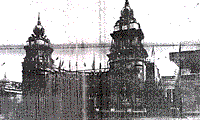
|
Fig. 1. The Baby Incubator Building.
|
|
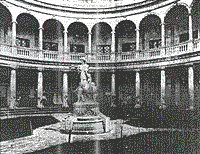
|
Fig. 2. The Interior Court.
|
|
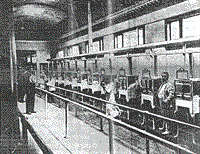
|
Fig. 3. The Incubators. Photograph taken before the Glass
Partition was Erected.
|
|
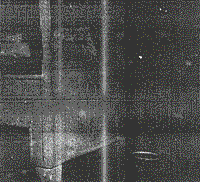
|
Fig. 4. Showing Cylinder where Heat is Applied.
|
|
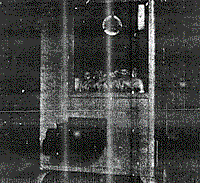
|
Fig. 5. Showing Metal Box attached to the side of the
Incubator into which the Air enters.
|
(To be Continued.)
Return to the Contents Page
Created 1/12/2000 / Last modified 7/16/2020
Copyright © 2000-2020 Neonatology on the Web / webmaster@neonatology.net





